Tokyo
The best places to visit in the city of Tokyo.
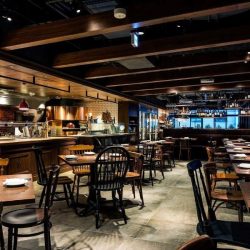
Daiwa Roynet Hotel Ginza
The Daiwa Roynet Hotel Ginza is a lovely and modern design hotel in the Ginza shopping district of Tokyo. The hotel stands out for being quite luxurious for a three star hotel and its premium location in the heart of Tokyo.
The Daiwa Roynet Hotel has beautiful and clean room which are a joy to sleep in, with especially nice bathrooms. With all necessities included, such as widescreen television with satellite, a fridge and free wifi. When you book at this hotel you can choose between smoking and non-smoking rooms, which is something you don’t see often anymore today.
Within the hotel you will find a cozy and warm Italian restaurant, where also breakfast is held with both western and Japanese dishes. And due to its location food lovers will be glad to know you will find restaurants of every budget nearby the hotel.
The hotel is within walking distance of Tokyo Central Station, but there is also a metro station in the same street as the hotel. So all touristic attractions are easy to reach from this hotel. As the hotel is located at the corner of the Ginza district you can also easily walk to the Imperial Palace Gardens to enjoy Japanese nature as well.
The Daiwa Roynet Hotel Ginza is one of the best hotels in Tokyo in their price range. So at Meet The Cities we can certainly recommend it to anyone, regardless whether you are a cultural, shopping or business traveler. As you get quite a bang for your buck.
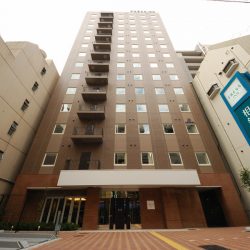
Sotetsu Fresa Inn Hamamatsucho-Daimon
What do the landmark Tokyo Tower and Zojoji temple have in common? They are both right behind the Sotetsu Fresa Inn Hamamatsucho-Daimon hotel. From this hotel you can simply walk to the most recognizable attractions of Tokyo, which can be found in Shiba Park. And on the days you want to check out the rest of Tokyo you can simply walk to the nearby Hamamatsucho station which connects you with all hotspots of Tokyo.
The rooms in this hotel are quite accommodating and have an attractive brown and white living design. The rooms are quite affordable, albeit in true Tokyo fashion they aren’t very spacious. Just a regular size you can expect in Tokyo. Everything is well taken care of and you can be sure that the facilities and the guests needs are all covered. Every room comes with a big screen television and a well kept bathroom. The hotel also offers free wifi and free Japanese tea for its guests.
The breakfast buffet is simple but good, as it offers a tasty selection of familiar western and fresh Japanese foods, so you can make a traditional Ochazuke or a fresh salad for example. If you are looking for a hotel on an extremely convenient location that offers good value for your money then Sotetsu Fresa Inn Hamamatsucho-Daimon is a great pick.
2-star hotels
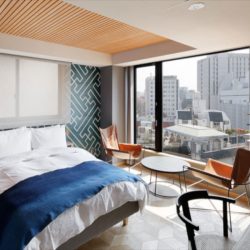
Wired Hotel
Finding a high quality 2-star hotel can be quite a challenge. But the Wired Hotel has truly outdone itself. It is our personal favorite and arguably the best 2-star hotel in Tokyo. And the reviews written by its other visitors agree with us.
As you walk in it is quite clear the hotel has given care and attention to its looks, as the hotel has a chic design and a warm atmosphere. The facilities of the hotel are all in order, with free-wifi, air conditioning and private bathrooms. The hotel has superior rooms available with a balcony, which is quite a nice touch in Tokyo.
The hotel also has a small restaurant / bar on the ground floor, where you can get a bite to eat or settle down for a cup of coffee after a long day out. Both the dinner and breakfast they serve is freshly prepared Japanese food.
The hotel is located in Asakusa, which is known for its shrines and local charm, right next to one of the main attractions of Tokyo, the famous Senso-ji temple. Which makes this hotel a perfect fall out base for a cultural trip. If you want to take the subway to explore the rest of Tokyo, then they’ve got you covered as well. As Asakusa Station is right behind the hotel.
If you’re not in a touristic mood you’ll be happy to know that the oldest amusement park in Tokyo, Hanayashiki, can be found right behind the hotel as well. So a stay here could literally end up in a rollercoaster ride.
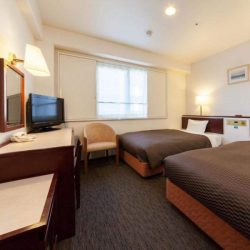
Nishitetsu Inn Nihonbashi
The hotel Nishitetsu Inn Nihonbashi is one of those hotels where everything just works. It’s a friendly service-oriented hotel where you can be assured of a comfortable stay at a decent location, allowing you to explore Tokyo in peace. And that’s exactly what you should want from a 2-star hotel.
In the morning your breakfast buffet is free and fresh. The rooms are clean, tidy and modern. The rooms have all the luxuries a regular hotel has to offer. In this hotel you will have your own private bath and shower. You can work at your desk. The rooms have a television, air conditioning and free wifi. All needs are covered.
You can even pick if you want a smoking room or a non-smoking room. Both are available. It’s actually quite rare in Tokyo that a 2-star hotel offers the complete package like this.
The hotel is located near the Nihonbashi district, which is considered the center of Japan. And if you head to the subway station behind the hotel, which is called Ningyocho Station, you can take the subway to easily reach all the best places in Tokyo with ease. And around the hotel you’ll find plenty of restaurants to settle down in.

Tokyo Plaza Hotel
If you come to Tokyo for shopping and enjoying the nightlife then the Tokyo Plaza Hotel is an excellent pick. Shinjuku, where this hotel is located, is one of the most popular shopping and nightlife areas in Tokyo.
This hotel is located on the main shopping street of the Korean part of Shinjuku, called Okubo Dori, where you will find many Japanese and Korean restaurants and lots of little stores. Think barbeque and k-pop. So you never have to wonder what to do when you come back to your hotel, because the entertainment is right at your doorstep.
Of course you come to Tokyo for Japanese culture, so within your street you will find a subway station connecting you to the most important subway line of Tokyo, the Yamanote Line, which goes directly to all important touristic and shopping districts of Tokyo.
Even after a single subway stop, which can also be walked as it’s just 850 meters (0.5 mile), you’ll arrive in Kabukicho, which is the nightlife area of Shinjuku where you will find fun arcades, movie theaters, restaurants and bars. And the main shopping streets of Shinjuku and Tokyo are right below it.
The hotel is well maintained. The rooms are equipped with a television, air conditioning and a private bathroom. There is free wifi. The breakfast here is on menu. And the hotel offers quite comfy bar where you can look outside while enjoying a cup of coffee. Overall we think it’s quite a good deal, especially when compared to other 2-star hotels in Shinjuku.
1-star hotels

Khaosan Tokyo Laboratory
Khaosan Tokyo Laboratory is a colorful hotel in the spiritual part of Tokyo. The design of the hotel stands out as they’ve picked a bright and lively colors to liven up for all the rooms.
As a 1-star hotel it’s not the most luxurious place, but the staff is friendly and the rooms are functional and clean. This hotel has made smart use of its limited space, as many rooms offer bunk beds allowing four friends to sleep in the same room. There is also free wifi, the rooms have a television, air conditioning and the regular rooms have their own bathroom. The hotel has a shared kitchen that can be used 24 hours a day. And there are plenty of restaurants and eateries nearby.
The hotel is located right next to Asakusa where the Buddhist Senso-Ji temple can be found within walking distance and lots of touristic items can be bought. Another great attraction 600 meters from your hotel is the oldest theme park in Japan called Hanayashiki. If you step out of the hotel you also see the Tokyo Skytree in the distance, which is the tallest building in Japan and a great vantage point to enjoy a panoramic view of the city from. And if all that is not up your alley, you can find a subway station practically in the same street as the hotel, which is called Asakusa station, from which you can easily travel across Tokyo.
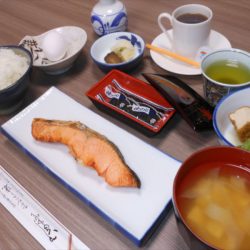
Hotel New Tohoku
Hotel New Tohoku is arguably the cheapest hotel one on this list, but it still stands outs due to its fantastic location. It’s within walking distance of Ueno Park, where you can find some of the most important museums of Tokyo, such as the Tokyo National Museum, Ueno Zoo, a fantastic Japanese lotus pond and more. And in front of Ueno Park you will also find Ueno Station, which is a railway station that connects entire Tokyo.
The design of the hotel is nothing fancy, it looks a bit dated, but it’s clean and everything is complete. The rooms come with free wifi, television, air conditioning and their own bathrooms. The hotel offers a Japanese breakfast, with salmon, rice, eggs, soup and more, which does cost a little extra, but it’s fairly cheap.
You might wonder why this hotel has 1-star. Well, it’s because the hotel lacks an an elevator, so you have to take the stairs to your room. Which is a bit inconvenient for elderly people. But for the rest the hotel is quite good. And you probably won’t find a cheaper hotel with the same quality. So it’s perfect for people who are traveling on a budget.
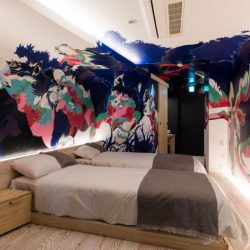
Artist Hotel – BnA HOTEL Koenji
At Meet The Cities we enjoy hotels that take the extra step to make their hotel appealing to customers. And the Artist Hotel has done just that. The hotel calls itself a bed and art hotel, for reasons instantly obvious to visitors.
The hotel has a great decor with art painted across the walls. The designer rooms are comfortable and cozy. The frontdesk of the hotel is not just a regular front desk, but an actual cafe and bar where you can take a seat and order your drinks. It’s certainly a joy to stay at this place.
All rooms come with their own bathroom and free wifi. But a 1-star hotel is not without its flaws. The rooms aren’t very spacious. And for that reason the rooms don’t have a television, so if you stay here you will be missing out on foreign tv channels most of us don’t understand anyway. But on the other hand you will be staying at a cheap designer hotel.
The area around the hotel is known as the creative part of Tokyo, where everything is still local and quint. With a lively alternative scene, an abundance of small bars and restaurants and boutique fashion shops. The hotel is located right in front of the Kōenji Station, which is a railway station connected to the Chūō Main Line. This means that you can literally leave your hotel, step into the railway station and within a minutes you will be in the busiest and booming parts of Tokyo, such as the Shinjuku shopping district. Making this hotel a great place to enjoy your vacation from.
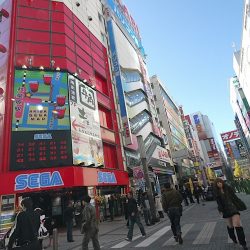
Arcade gaming in Akihabara
In Japan arcade gaming is still as popular as ever. And the arcades are bigger than anything you’ve seen before. The Akihabara district in Tokyo is known for it’s many arcades.
As you arrive at Akihabara Station and enter the streets on the west side towards electric town you will come across several multi storey arcades. With a huge seven floor Sega arcade being the first to welcome you. And next to it you will find the professional arcade Hirose Entertainment Yard (HEY). You are now in the main street, Chuo Dori, of the otaku heaven called Akihabara which is dedicated to gaming and anime. As you look through the streets you can’t help but notice that the Japanese have embraced geek culture in all its facets and it’s marvelous.
Both singleplayer and multiplayer games are well represented in the Tokyo arcades. While we were there we have seen large halls filled with mech simulators, shooting games, retro games, racing simulators, bullet hell games, punching games, claw machines, musical drum games, guitar games and everything else you can imagine. Many arcades like Taito station welcome people until midnight and you will find people playing there all evening.
Visiting the arcades in Akihabara is one of the best things to do in Tokyo as the variety of games provide endless hours of fun, especially when you play the multiplayer games with a partner or with your kids. And after you are done you can enjoy the rest of the day in the street with anime stores, cosplay cafes and retro gaming stores.
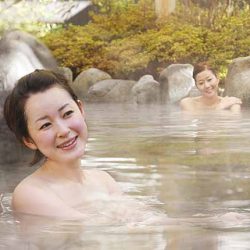
Ooedo-Onsen Monogatari
Relaxing in hot springs is a traditional part of Japanese culture. Just like enjoying Japanese gardens and Japanese food, going to a bathhouse and bathing and relaxing in warm healing mineral water is an intrinsic part of the Japanese lifestyle. The Japanese call these therapeutic bath houses an Onsen. And Ooedo-Onsen Monogatari is one of the largest hot spring bath houses in Tokyo.
As you arrive you receive a Japanese outfit called a Yukata, which is what you will wear during your stay. There are a variety of baths you can enjoy. Starting from a footbath where you can sit down with your family. Then you can proceed to the main hot spring baths, where you can choose between several natural hot mineral baths, bubble baths, and outdoor baths in the garden. After which you can enjoy a nice sauna or take a nap in the relaxation area.
The complex also has a spa, where several types of massages, skin treatments and even fish therapy is offered. And afterwards you can enjoy one of the restaurants in the edo-era styled complex, where you can get some tasty Japanese food like yakitori, sushi, ramen and noodles. Or simply enjoy some Japanese treats.
The Japanese honor their traditions, so for travelers it’s worthy of note that the main hot springs are separated by gender, as people will be nude. And there is a rule against tattoos in most hot springs in Japan. The Japanese also believe bathing here does sooth your mind and enhance your blood circulation. If you are wondering what to do in Tokyo and are looking for a cultural and pretty relaxing experience then this attraction is certainly worth a visit. As it truly adds to the Tokyo experience.

Ueno Zoo
The Ueno zoo is the oldest zoo of Japan. And animal lovers will be glad to know you will find a very diverse array of animals here, as the park houses over 400 different species. From the Chinese panda bear, cute monkeys like the ruffed lemur and Japanese birds, to the well known lions, pinguins, tapirs, seals, giraffes, turtles and gorillas. The park also has quite some exotic species such as Okapis, which looks like a mix between a zebra and a giraffe.
Of course for small children it can be fun to touch animals, so the zoo also has a children farm where you can pet some farm animals like rabbits, donkeys and sheep. The zoo is incredibly cheap and even free for younger children, which makes it a perfect destination for a great family day out on a budget.
The zoo can easily be reached by taking the metro to Ueno Station, which is located in front of Ueno Park. As you enter the park you will find some of the most important museums in Tokyo and Ueno Zoo itself. Surrounding the zoo you can find an abundance of things to do, but the zoo itself offers so much that you can easily spend the entire day in it.

Joypolis
Joypolis is a fantastic Sega theme park in Tokyo with fairly unique attractions. This colorful wonderland is one of the biggest indoor theme parks in Japan and one of our favorite amusement park in Tokyo due its unique vibe, as it has an emphasis on high tech interactive attractions with many arcade elements. The whole setting feels like you entered a steampunk neo-tokyo world filled with familiar Sega faces.
Fly upside down in a spinning roller coaster. Put on VR goggles, grab a laser weapon and enter a virtual battle with your friends. Race against each other in high speed without a drivers license. Grab a Donald Duck, Sonic or Pikachu doll. Fly around in a Star Wars space ship. It’s all possible and indeed a joy to experience.
Joypolis can be found in Odaiba and the Tokyo railway stops right in front of the door. And surrounding Joypolis you will find some cool other touristic sights, such as the headquarters of Fuji TV where you will find a giant mech in front of the door, that you can also check out after your visit. So there is no excuse not to check out Joypolis when you are in Tokyo.
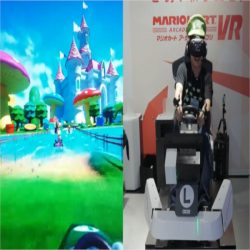
VR Zone Shinjuku
VR Zone Shinjuku is a virtual reality arcade from the famous game developer Bandai Namco, who made big brand games like Pacman, Dark Souls and countless anime games with big names like Naruto and Dragon Ball Z. There is no one more qualified to make a VR arcade than them, and they certainly made something beautiful.
VR Zone offers a wide range of virtual reality experiences for you to enjoy. The popular Mario Kart game can be experienced in an immersive 3D experience where you race against your peers. You can enter a giant mech from Evangelion. Or enter the world of Dragon Ball Z and fire a Kamehameha with your hands. Or you could ski off a mountain in Ski Rodeo. There is an abundance of quality offerings to experience, which makes VR Zone Shinjuku certainly worth a visit.
If you are wondering what to do in Tokyo and want an attraction that you can enjoy with the whole family, then VR Zone Shinjuku is a solid pick. And the great thing is that it’s also located in the touristic Kabukicho, Shinjuku, so you can be sure to find lots of great eateries and shopping areas nearby, which you can visit aftwards.
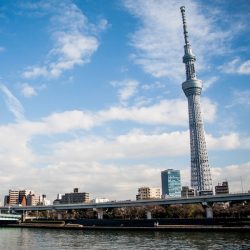
Tokyo Skytree
The Tokyo Skytree is an architectural marvel in the heart of Tokyo. It’s the tallest structure in Japan, the biggest tower on the planet and the second tallest structure in the world with an impressive height of 634.0 metres, which is 2,080 ft. The only taller building is the Burj Khalifa which stands in Dubai. It serves as a futuristic looking media broadcasting tower.
At the base of the Tokyo Skytree you will find a shopping mall with plenty of souvenir shops, more than a hundred fashion shops and countless restaurants with quint Japanese snacks tempting tourists to try some local delights. On the fourth floor is a ticket counter where you can buy a ticket for the observation deck on floor 350 and floor 450, which are respectively 350 and 450 meter above ground level. Offering the best panoramic view imaginable over the endlessly outstretched city of Tokyo on one of the highest observation decks on the planet. From here you can even see Mount Fuji in the distance.
Considering a ticket to the observation decks of the skytree is actually quite reasonably priced this is a must do attraction in Tokyo. If you go sightseeing in Tokyo then the Tokyo Skytree is an obligatory visit. It’s an unique experience which really can’t be found elsewhere.
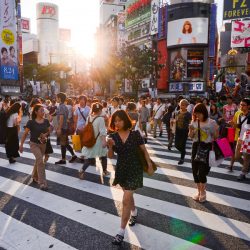
Shibuya crossing
Shibuya crossing, also known as the Shibuya Scramble, is of the most recognizable places of Tokyo for a good reason. In Tokyo they love to break global records and Shibuya crossing sets its own record as the busiest intersection of the world.
This crossing has the stereotypical Tokyo image with tall buildings, colorful signs and the biggest crowd you’ve ever seen crossing the intersection at the same time as soon as the traffic lights allow it. You feel like you’ve just arrived in the future watching Shibuya crossing as it’s exactly what you’d imagine to see in one of the biggest metropoles cities in the world. And you can feel the energy that radiates from this busy place.
Behind the crossing you will find a statue of faithful Hachikō, which is a dog renowned in Japan for it’s loyalty. As the dog went to Shibuya crossing every day to wait for his master to return from work, even for nine years after he was deceased. The Japanese took notice and this Akita dog became a national inspiration.
Behind Shibuya crossing you will find the most popular shopping district of Tokyo. Often considered the most colorful district of Tokyo. Here you can find the latest youth trends in Japan, arcades, department stores for shopaholics, unimaginable niche stores and plenty of sushi bars to enjoy. So if you are going to check out Shibuya crossing then at Meet The Cities we recommend also check out the neighborhood behind it for an awesome shopping experience.
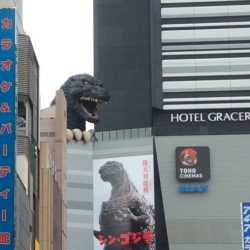
Godzilla head
As you walk through the shopping district of Shinjuku you might notice that there is a giant lizard looking down on you. This lizard is of course one of the trademark monsters of Tokyo. The most famous inhabitant of Tokyo called Godzilla. And he’s very much alive!
You can’t go to Tokyo without meeting up with Godzilla himself, so keep an eye out for him. You will find the 40 feet (12-meter) tall head of Godzilla in the Kabukicho entertainment district of Tokyo, on top of Hotel Gracery Shinjuku, and peeking over the Shinjuku Toho Building, which is a towering cinema to the north of Shinjuku station. Every so often you can see Godzilla spewing fire while he growls at the crowd. Godzilla truly adds some flavour to your vacation photos, so don’t forget to take a picture of him.
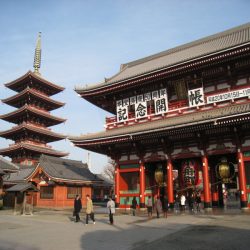
Sensō-ji
The Sensō-ji temple is the most visited religious site in the world with a mind boggling 30 million visitors a year. What makes this site even more interesting is it’s historical significance as the oldest temple in Tokyo. Whether you are on a spiritual journey or simply wish to enjoy the local culture and traditional architecture the Sensō-ji temple is an amazing place to visit in Tokyo. The temple is dedicated to the buddhist goddess of mercy
Leading up to the temple you have to pass the impressive thunder gate Kaminarimon with statues of the wind and thunder god watching over it and a giant 700kg red and black lantern hanging below it. As you pass the gate you will end up in the Nakamise Dori street, where you will find rows of souvenir and gift shop vendors offering neat little memorabilia to take home. It’s a good idea to taste some typically Japanese sweets here.
At the end of the street is the Treasure-House Gate, known as Hōzōmon, on which you will find two statues of giant guardians protecting the complex. Once you pass through this gate you enter the sacred temple complex grounds. From here you will have an unique view of several landmarks of Tokyo. To your right you can view the Tokyo Skytree, in front of you is the picturesque main hall of the Sensō-ji temple, also known as the Asakusa Kannon Temple, and on your left hand is a 5 storey tall pagoda reaching for the sky.
Throughout the complex you will find several buddhist temples with classic white and red architecture and golden finishings. You will notice locals cleansing themselves with water, burning ritual incenses and trying to peer into the future with O-mikuji fortune lots. It’s an enjoyable religious and cultural experience to visit the temple and a trip to Tokyo is not complete without it.
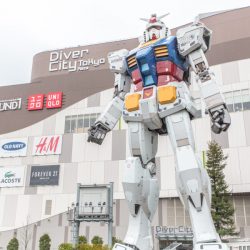
Odaiba
Odaiba is often known as the entertainment district of Tokyo. Where you go to you leave the old and traditional Tokyo behind and step into a modern and futuristic world filled with things to see and do. You can reach Odaiba by crossing the iconic rainbow bridge, which is a white bridge that lightens up at night and connects Odaiba with the mainland. The face of Odaiba is the headquarters of Fuji TV, a futuristic building with it’s iconic spherical observatory called hachitama, which acts as a great vantage point to see the skyline of the city from.
Behind the office of Fuji TV you will find a life sized Gundam. For the uninitiated a Gundam is a large Japanese mech from a television series with the same name. So yes, in Tokyo you can and should go take a picture of yourself with this 20 meters tall beast of a robot. It makes for a great vacation photo truly part of the Tokyo sightseeing experience.
If you prefer to stay outside then you can enjoy a panoramic view of Tokyo from one of the tallest ferris wheels on the planet, the Daikanransha. At night the 115 meters tall ferris wheel lights up and can be seen from across the city.
Odaiba has multiple family friendly attractions, such as a giant arcade and gaming hall called Tokyo Leisure Land, which also has a haunted house, karaoke and bowling. The perfect place to enjoy with the family and unleash your inner nerd. The locals in Tokyo are huge fans of arcades which clearly shows in the massive offering of games.
You will also find a spa theme park known as Oedo Onsen Monogatari in Odaiba, where you can enjoy the Japanese Onsen culture, which are relaxing warm hot springs. There are 13 indoor and outdoor baths to enjoy in this spa complex. You can also alternative your hot springs visit with a nice therapeutic head or body massage or a visit to one of the many restaurants to enjoy a nice plate of sushi.
Other things you will find on this artificial Island are the statue of liberty, a replica of the real thing in the heart of Tokyo. Toyota’s extensive car exhibition called Megaweb. And iconic structures such as the Tokyo Big Sight convention center, that looks like four upside pyramides held up in the air. With all the things to see and iconic landmarks the Island Odaiba in Tokyo is a necessary part of the citysperience that you can’t miss during your trip to Tokyo.
Between the sightseeing in Tokyo you can also shop in one of the many themed shopping centers Odaiba has to offer, such as Venus Fort, Aqua City shopping center, Diver City shopping center and the Decks Tokyo Beach shopping mall.
As you can imagine Odaiba is richly filled with things to see and do, so it is absolutely a must place to visit in Tokyo. At Meet The Cities we certainly recommend a visit. If you are wondering where to go in Tokyo then make a day free to go sightseeing in Odaiba, as you can really spend days enjoying yourself here.
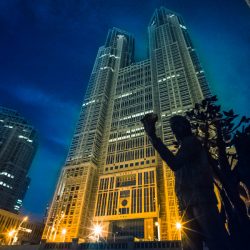
Tokyo Metropolitan Government Building
The Tokyo Metropolitan Government Building is one of the more recognizable landmarks of Tokyo. This 48 story complex reaches a massive height of 242.9 meters (797 ft) making it pretty hard to miss. On the 45th floor of the two towers you will find a free observation deck open to the public making it well worth to visit this building as you get to enjoy a beautiful panoramic view over the city.
The Tokyo Metropolitan Government Building lies a bit outside of the touristic path, but it can easily be reached by taking the metro. Just head over to Shinjuku Station and then it’s within walking distance. It should be noted that Shinjuku Station is the busiest railway station in the world which is a fun thing to see by itself.
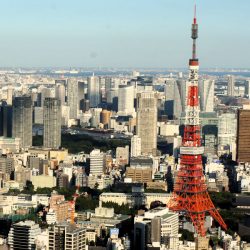
Tokyo Tower
A Tokyo landmark building you will often see on television is the Tokyo Tower. This sight looks like the Eiffel Tower, except it’s even bigger and painted orange and white. It’s currently the second biggest structure in Japan standing at an impressive 332.9 meters, which is 1,092 ft.
It functions as a radio tower, but the Japanese quickly found out it serves as an amazing tourist attraction as well, considering the amazing view over almost the entire city of Tokyo from the observatory at 150 meters high and the second smaller observatory at 250 meters high. Both observatories are open to tourists, but there is a fee attached to it. When the Tokyo Tower was built in 1958 it stood as a marvel of engineering in Japan representing the economic rebirth of the nation. Now it stands as a landmark and a fantastic vantage point.
At the bottom of the Tokyo Tower you will a shopping mall called FootTown. Here you will find several shops and restaurants. And more notably there is an expansive aquarium with more than fifty thousand fish in it. The Guinness World Records Museum of Tokyo can also be found here. And one of the cooler things to do at FootTown is the optical illusion museum called ‘Tokyo Tower’s Trick Art Gallery’, where lots of stereoscopic art is on display. Ensuring lots of neat photo opportunities.
If you want to take some pictures of the tower itself, then a great place to do that from is the Shiba Park. For the best shots people often try to capture the famous buddhist Zojoji Temple and the Tokyo Tower on the same picture, portraying a beautiful contrast between the old and new Japan.
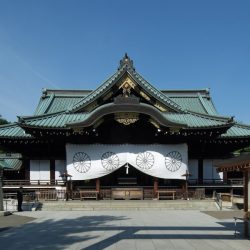
Yasukuni Shrine
As with many war monuments the Yasukuni Shrine is a controversial yet beautiful Shinto shrine. The shrine is dedicated to all soldiers that lost their lives in the service of Japan. A noble shrine, but it also has a controversial nature. As among the list of soldiers some war criminals can be found. The shrine’s museum aims to give a neutral presentation of the history. But critics claim the museum does give a biased view of history, as to only speak good of the dead, which does not fall in good earth with everyone.
This dualistic nature of the Shinto shrine makes it an interesting travel object. So for historical travelers it’s certainly an interesting place to see in Tokyo. Over two and a half million soldiers are honored at the shrine. So as you can imagine the Japanese have created a beautiful spiritual building complex, with a two story wartime museum, multiple Torii gates, an abundance of cherry blossom trees and a calming pond where people can reflect upon the past.
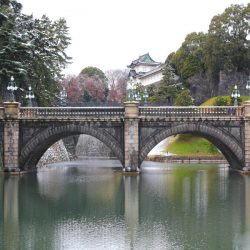
Seimon Ishibashi bridge
The Seimon Ishibashi bridge is one of the most recognizable bridges of Japan, as it leads to Edo Castle. The bridge is also called the Seimon Stone Bridge or the Eyeglass bridge due to its distinct looks. And behind the bridge you will a metal bridge called Nijūbashi leading to the Imperial Palace.
Although the bridge itself is not open to the public you can still make some characteristic pictures over the stunning double bridge as it passes over the canals, leading into the fortified walls with the Imperial Palace in the background.
If you go sightseeing in Tokyo then you surely want to see this bridge. As you pass the bridge you can also head into the Imperial Palace East Gardens for a relaxing stroll and to find out what remains of the edo castle.
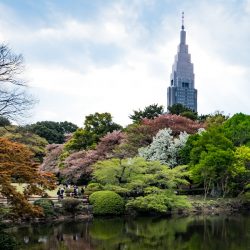
Shinjuku Gyoen National Garden
One of the most beautiful sceneries in Tokyo can be found in the Shinjuku Gyoen National Garden. This popular park in Tokyo is considered one of the most important parks in Japan from the Meiji era with thousands of trees from different regions of the world covering an impressive 58.3 hectares has varied strolling paths with the typical atmosphere Japan is renowned for.
A favorite Japanese pastime is the centuries old tradition of Hanami, which translates into flower viewing. And this park is a popular destination for it. This parks offers anything from calm paths past various ponds of water, to fantastic picnic sites between over 1500 cherry blossom trees which all come to blossom during the early spring. And maple trees coloring the park during the autumn. Which makes this park an ideal place to visually experience the ever changing seasons of Japan.
This park is actually one of the most appreciated cherry blossom parks in Tokyo and locals will spend their lunchtime to come here and appreciate them. A very typical trait of the Shinjuku Gyoen National Garden is that there are a lot of pathways over small streams of water ensuring relaxing and diverse paths with an amazing backdrop.
On occasion you will spot the skyscrapers of Tokyo above the horizon, creating some nice photo moments. In the north of the park the design naturally flows into a more French and English park design. Another notable feature of this park is the traditional Japanese tea house you will find here and the 15 meters tall greenhouse where tropical plants are put on display for you to enjoy.
This national park does has a small entrance fee, which is quite worth it if you want to enjoy a nice change of pace in the best reviewed traditional park in Tokyo. It is the best park in Tokyo for enjoying authentic Japanese landscape architecture.
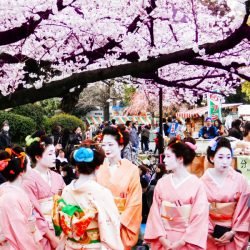
Ueno park
Ueno park was the first public park of Japan. And it is often considered the cultural heart of Tokyo with a near infinite amount of recreational value. As the park is filled to the brim with activities it’s not as calm and natural as the other parks, but Ueno park is a wonderful place that you cannot miss when you visit Tokyo.
Ueno park is mostly known for housing the most interesting museums in Tokyo. You will find the Tokyo National Museum here, which is arguably the most important museum in Japan and spans five buildings, and the National Museum of Nature and Science. The Ueno Zoo can be found in this park, which is the oldest zoo in Japan and houses crocodiles, giraffes and even cute panda bears. The Ueno Zoo also has one of the architectural highlights of Tokyo, which is the prestigious five story Kan’ei-ji temple.
It’s also an excellent location for cherry blossom viewing, which can be found around the main pathway and across the pond. You can even rent a small boat to romantically enjoy the nature from the Shinobazu Pond, which is a pond filled to the brim with the typically Japanese lotus beds.
The park is also home to multiple religious shrines in traditional Japanese architecture, such as the beautiful centuries old Shinto shrine, called the Ueno Toshogu Shrine, and the Bentendo temple in the heart of the pond dedicated to the goddess of fortune.
At Meet The Cities we have grown a certain fondness of this park in Tokyo. And if you are on a cultural trip to Japan you will inevitably find yourself in this park as well.

Yoyogi Park
Yoyogi Park is an especially aesthetically pleasing park and a peaceful oasis in the heart of Tokyo. The park is often used as a gathering place of groups of people wanting to meet up in Tokyo and openly express themselves in a beautiful environment, such as martial artists and cosplayers. Street performers and rockabillies may be found here during the weekends. Elderly people exercising. And festivals are often celebrated here. It’s pretty much the hangout park of Tokyo.
The park itself is quite large and resembles a forest with a multitude of walking paths. In the south of the park there are many places to sit down at small fountains, where people can enjoy their lunch while enjoying the harmonious nature and rows of blossom trees. You will also find people skating and taking a stroll with their families.
To the north of the park you will find one of the highlights of Tokyo. Within the forest you will find the sacred Meiji Shrine, where the former Emperor Meiji is honored. When you visit the free Yoyogi Park in Tokyo then it’s a good idea to also visit the shrine to see how the Japanese honor their people.
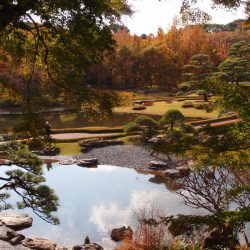
Imperial Palace East Gardens
The emperor of Japan has it’s main residence in Tokyo. And behind the palace you will find a garden with old ruins and fortifications, such as the ruins of the old Edo Castle. Within the park you will also find the Museum of the Imperial Collections, which is a modest but free to visit museum containing items from the imperial household. The Imperial Palace East Gardens also contain the most famous bridge in Tokyo, the Seimon Ishibashi bridge, which leads to the main gate of the imperial palace. As you might have guessed this park will mostly appeal to the historical and cultural tourist.
The nature of the park is less refined than in some of the other parks, but still a joy to experience. The park has large open green areas between walking paths, where you can take a nice relaxing stroll surrounded by trees. In the north west of the park you will find several trails with plants from across Japan, which is especially charming next to the pond in the Ninomaru area.
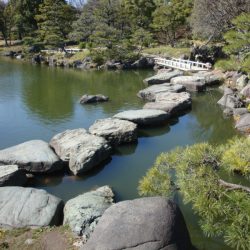
Kiyosumi Garden
Kiyosumi Garden is one of the smaller parks, with beautiful natural environmental architecture. As in typical Japanese fashion you are led past a small lake with large orange carps in it, ducks and even turtles. A defining feature of this park is that natural rocks from across Japan were placed on the side of the lake adding to the authentic atmosphere. On several places you have to walk over carefully placed natural stones to get across the water or over the grass.
The park is a little gem in the heart of Tokyo and perfect for escaping the busy city life and getting some breath of fresh air. If you stay in Tokyo for a longer period of time then this picturesque garden in Tokyo is a nice little catch to explore if you are looking for a place to clear your head. The garden comes with a Japanese teahouse where visitors can drop by.
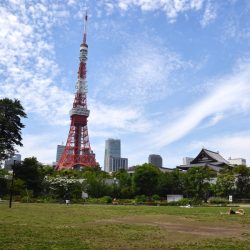
Shiba park
Next to the landmark Tokyo Tower you will find Shiba park. As you can imagine this is the best park in Tokyo to visit if you want to take top notch pictures of the Tokyo Tower. It’s interesting to note that Shiba park also belonged to the first group of public parks in Tokyo.
The park itself isn’t really suitable for escaping the city life, but instead it’s filled with religious attractions. The park is build around the Buddhist Zōjō-ji temple. Five shoguns were buried within the mausoleum of the temple signifying its religious importance to the locals. The temple is protected by the Sangedatsumon gate and walking through this gate is said to free your mind from the earthly vices of greed, hate and foolishness.
The park has multiple shinto altars with the ever so recognizable Japanese architecture. Easier to miss is the typically Japanese ancient key shaped burial mound from the fifth century, which is a large mound serving as a tomb of mysterious origins with trees growing on top of it. As it blends into the environment most tourists will miss this historical artifact.
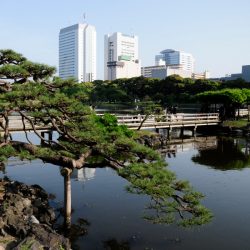
Hamarikyu Gardens
Next to the Sumida River, in the bay of Tokyo, you will find the public garden park called Hamarikyu Gardens. This serene garden has a very distinct style of Japanese landscaping, as the park stands out for it’s excellent use of water, as the park is surrounded by water from the bay. Within the park itself you will find Shioiri Pond, which you can cross over using a wooden bridge for a stunning view over the water.
If you follow the path around the pond you will come across seasonal trees and flowers, such as plum trees and cherry blossoms. This delightful green path makes Hamarikyu Gardens one of the best gardens in Tokyo to stretch your legs in. And if you keep going you will come across several picnic sites which are often enjoyed by the locals. As you stroll across the park you might notice some Tokyo highrise, which stands in stark contrast with the sereness of the park, offering some excellent photo moments.
The Japanese know how to live the good life. At the center of the pond you will find a traditional Japanese teahouse where you can relax and enjoy some traditional green tea with a beautiful view. This tea house can be reached by crossing one of the three bridges towards it.
The Hamarikyu Gardens originally functioned as a hunting grounds of the Shogun Tokugawa family, but in 1654 the park was enclosed with water and in 1707 the Tokugawa gave the park it’s current purpose. Including the teahouse we can still enjoy today. This park is now designated as one of the special historical sites of Japan for its scenic beauty and historical relevance.
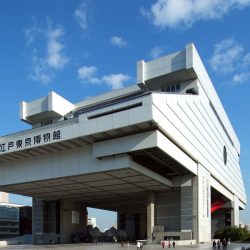
Edo-Tokyo Museum
The Edo-Tokyo museum is a museum about the history of Tokyo. It puts a focus on the Edo period, which is between 1600 and 1868 when the Tokugawa shogunate ruled over Japan. As Japan was fairly isolated from the world this era portrays Japanese culture quite well. The museum will portray Japanese architecture of that period, portray the daily lives of people, you will discover early Japanese publications and will have to joy of discovering how people entertained themselves. It’s a very lively museum which makes it accessible to both novice museum visitors and people who are looking for a deep cultural dive into the spirit of Japan. The Edo-Tokyo Museum is certainly one of the best museums in Japan and well worth a visit.
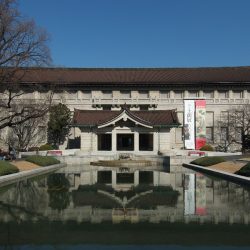
Tokyo National Museum
The Tokyo National Museum is the most extensive museum in Japan. As it is the largest art museum in Japan it has to be spread across six buildings within Ueno park in the heart of Tokyo. The museum is filled different kinds of artworks, historical pieces from throughout the ages and archaeological treasures that go all the way back to an impressive 12.000 years ago. The museum has a strong Japanese undertone, but other asian pieces are also on display here. From statues and masks to samurai outfits and Japanese paintings.
The perception of Japanese art divers quite a bit from western art, which makes it well worth to explore the well preserved national heritage pieces that the Japanese have collected over the millennia. It should be noted that the museum offers all information in a multitude of languages, including English, German, French and Spanish, so travelers should have no trouble finding information in the museum. At Meet The Cities we were especially impressed by the rich sculptures the museum has. If you are interested in all facets of the history of Japan and Asia then this is the best museum in Tokyo to check out.
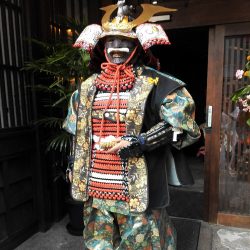
Samurai Museum Tokyo
Honor, bushido, swords and beautiful costumes. Samurai are one of the most well known icons of Japan, so this list would not be complete without the Samurai Museum in Tokyo. This museum showcases relics of the samurai who played a prominent role in Japanese society over the course of multiple centuries.
The museum is modest in size, but the collection of armors, helmets and weapons is pretty impressive and fitting for people taking a cultural city trip to Japan. The museum also performs a samurai show four times a day. And it is possible to try on a samurai outfit, which makes for a memorable photo moment. The samurai museum is a great way to get into the spirit of Japan.

National Museum of Nature and Science
The National Museum of Nature and Science, which was formerly known as the National Science Museum of Japan, is an educational museum in Japan. The museum has a focus on the history of life, the development and technology of mankind and the universe itself. So you can expect a wild array topics to be covered, from the animals of earth, to several huge real dinosaur skeletons, rare meteorites and stones, how hunter gatherers settled in Japan up, to Japanese inventions and engineering.
The museum is enjoyable for all ages, so if you are with kids and you want to show them a real Triceratops then this museum is perfect. The artifacts of the museum tell a very visual story of our planet which is quite enjoyable and certainly left us pleased. As the museum is located in Ueno park you can also easily combine it with other museum visits.
